
 |
Atiu - Rarotonga - Tahiti - Huahine 5 to 9 March |
It pelted with rain on our last morning on Atiu but by the time we left in the afternoon, it was just cloudy as it had been the day we arrived. We just topped the clouds at 8,000 feet, then the weather cleared as we approached Rarotonga. We made a scenic tour of the island before landing which confirmed our first impression that it was a beautiful island now fully exploited by the tourist industry. Thankfully, though, they hadn't ruined it with apartment buildings as on the Spanish coast. We arrived back at the Club Raro hotel to find a fax waiting for us with the clearance from Kiribati (Christmas Island). But there was nothing from Mobil in Tahiti so we would have to chase them up on arrival in Papeete. On the news that evening, they announced that due to the gravity of the dengue fever epidemic, they would be closing the schools on Rarotonga for 2 weeks. The schools, houses and tourist hotels were to be sprayed with some mosquito-killing substance. We doubled up on our spray and hoped that the few mozzies that had managed to bite us weren't infected with the disease. The next morning we arrived at the airport an hour later than scheduled. Flemming had told the fuel guys that we would be there at 9 a.m. and they had been waiting at our plane with the fuel truck all that time! They were quite cheerful about it, though. I don't think they were very busy otherwise. We had to zig-zag a bit on the flight to avoid some isolated CBs. But all was well and Flemming had fun saying 'Bonjour' to the air traffic controllers for the first time since we left Geneva on 29 October. We landed in Papeete after 4 hours 20 minutes. After completing customs and immigration formalities, we taxied over to the aeroclub where we were greeted by club members and flight instructors Jean-Raphael and Didier. There was the same welcome and atmosphere as at any aeroclub in France. We drank beer and exchanged flying stories. Like us, Jean-Raphael had flown in Senegal and knew the Philip family of Hotel de la Poste in Saint Louis. And, naturally, they also knew our Earthrounder friend Claude Meunier who flies into Papeete from time to time. Although Claude has been living in Australia for many years, he is originally from Tahiti. We had been warned that French Polynesia would be expensive and that was no exaggeration. Prices are double those of Cook or Samoa. The only cheap hotel that our guide book recommended was fully booked. As in Rarotonga, we had a lot of work to do before we could take off for the outer islands, so we opted for the Hotel Matavai which was quiet but near to town and had air conditioning and a direct phone line from the room. And as in Rarotonga, we didn't get time to use the swimming pool. Apart from the climate, Papeete was quite similar to a large town in France. They even had 'belle époque' street lighting! The next day we both had a long-overdue haircut at Olivier Coopeur's [no, not Coupeur!] salon. Olivier cut my hair while a lady assistant cut Flemming's. Olivier and I had a lot to talk about as we both lived in Rio de Janeiro in the late 70's. Flemming had an equally good time with his beautiful blonde Parisienne who was into parachute jumping. Although the civil aviation authorities had cleared us to fly out of French Polynesia from Rangiroa, Customs had not given their approval. Rangiroa is not a normal port of entry so special permission was needed. This had to be obtained before we paid Mobil US$ 570 for the shipment of 400 liters of Avgas to Rangiroa. Thanks to our direct phone line, this was all arranged the next morning and we were at Papeete airport by midday. Flemming talked to the meteorologists about getting accurate weather data for the long flight from Rangiroa to Kiribati and paid all the landing fees for our flights in French Polynesia which came to just US$ 40. The aeroclub is the other side of the runway from the airport terminal. Since we had no pass, a club member had to drive us across, so we called the aeroclub when we were ready. It was the club president, Alain Lafille who came and picked us up. Chief mechanic, Christian Baron, helped us with refuelling. We just put in enough for the flights as far as Rangiroa and to get us back to Tahiti in case the shipment of fuel didn't arrive as planned. (Remember our experience in Tonga?!) The weather was fine for the short one-hour flight to Huahine. We stayed at Pension Chez Guynette in the main village of Fare. Guynette must have left some time ago and it is now run by a friendly American woman called Marty. The main street ran past the bar terrace. Beyond that was the beach and to our left the port. It was fun to sit drinking a beer and watching the little world of Huahine go by. Apart from the tropical vegetation and the Polynesians, one could almost have been in France in the 1950s. Chez Guynette was a cosy little place but a bit too cosy at night in our small room with just the fan to cool us. I found myself thinking longingly of our chalet in the cool Alps. After a month of 32 C temperatures during the day, only dropping to about 28 C at night, I'm ready for some cooler weather, and am looking forward to arriving in Hawaii where we can always escape the heat in the mountains if it gets too hot by the coast. And, admittedly, I am also looking forward to getting the two long stretches of ocean behind me, namely Rangiroa to Christmas Island (Kiribati) - about 8 hours - and Kirabiti to Hawaii - about 7 and a half hours. The next day we went on a boat tour of the lagoon with a charming young half Polynesian-half English girl as our guide. She pointed out the shape of the island which looked like a reclining pregnant woman from the boat. Hua means 'phallus' (from a rock we saw on Huahine-iti) while hine comes from vahine (woman). French Polynesia is famous for its black pearls and we visited a pearl farm and had the long process of producing cultured pearls explained to us. The snorkelling was the best we'd had in the South Pacific so far, and Flemming had fun playing with a moray eel. Our lunch of marinated raw fish and papaya with grated coconut was consumed from plastic chairs in the water, Polynesian style. We rented a Peugeot 106 the next day and had a nice leisurely drive around the islands of Huahine-nui (great Huahine) and Huahine-iti (small Huahine) which are connected by a bridge. The drive - with beautiful views of the lagoon and lush green mountains in the middle - didn't take much more than an hour so there was plenty of time for stops and lazing on the beach. We lunched at the pension Mauarii at the southern end of Huahine-iti by a good snorkelling beach. It also had an 'Internet café' with just one computer available. We haven't been able to upload our website or get direct access to the Internet from our computer since we've been in French Polynesia as there is no iPass roaming agreement with this country. So we've made use of Internet cafés where available to send and receive emails. Their keyboards are the devil to use, though, as all the letters are in the wrong place! At the Mauarii restaurant we met an interesting American guy, called John Stokes. His mission in life is to teach indigenous people to preserve their culture through what he calls 'tracking' projects. He said that a Polynesian told him: 'You are the first white guy to tell us not to lose sight of our language and traditions. They have always told us the opposite!' According to the newsletter John gave us, some of the projects he organized last year were 'following the tracks of a stalking mountain lion in the riverbed sand with young guys from Zuñi pueblo; making traditional Iroquois pottery from hand-dug clay with young members of the Six Nations; and a tracking/cultural awareness class at the Saami village of Saltaluokta in northern Sweden. In case you'd like to know more, you can visit The Tracking Project website. Just before sunset we visited the marae of Maeva village, a rather eerie archaeological site, which used to be a meeting place where human sacrifices and burials took place. That evening we went to one of the large resorts to see a Polynesian dancing show. It took some persuading to get Flemming to pose for the photo with all the lovely ladies. He has been suffering from stagefright ever since his experience in Tunisia some twenty years ago when he was invited up on stage to join the belly dancers and got in the way of their immense hips, resulting in a couple of cracked ribs (hard to believe, but true). Thanks: Aéroclub UTA, Claude Meunier |
Click on image to enlarge, click browser back to return |
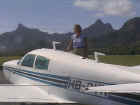 Departing from Rarotonga |
|
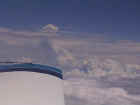 One of the isolated CBs en route to Tahiti |
|
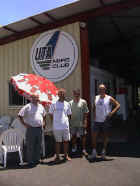 The UTA aeroclub in Papeete: Alain Lafille (President), Flemming, Christian Baron (chief mechanic) and Eric Ferry (mechanic) |
|
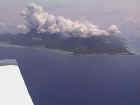 Passing Moorea on our way to Huahine |
|
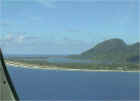 Left base for Huahine |
|
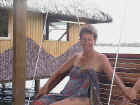 At the pearl farm |
|
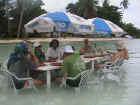 'Les pieds dans l'eau' - lunch Polynesian style |
|
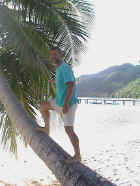 No problems climbing this coconut palm! |
|
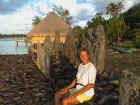 Sitting on one of the tombs at the marae of Maeva (Huahine) |
|
 Huahine fishermen near the marae |
|
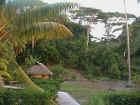 View from the marae |
|
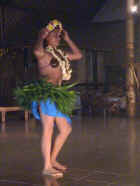 The dancing girls wear bras made of coconut shells |
|
 Big chief Flemming is 'bien entouré'! The girls' skirts are made of hibiscus fibre |